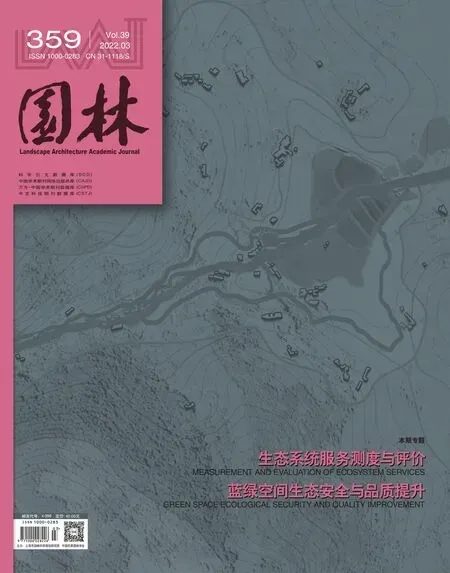“三界”并举发展风景园林
2022-12-06张浪
全球性的新冠疫情、河南郑州暴雨、汤加火山喷发……世界瞬息万变,城市面临的安全问题也复杂多变,依赖并局限于单一学科很难真正解决问题,这就需要我们拥有“天人物我,融通为一”的思维模式。这与老子“道生一,一生二,二生三,三生万物”的宇宙生成论不谋而合。“十四五”时期,我国生态文明建设进入了以降碳为重点战略发展阶段、生态环境质量改善由量变到质变的关键时期。以人与自然和谐共生为目标,探索城市通过内涵式发展和有机更新,提高生态系统服务水平和效率,提升人居环境品质,这就倒逼风景园林专业的思维“无界”、工程技术“融界”,并通过内核明确的“跨界”,实现其本专业创造新价值和新发展。
生态系统服务(Ecosystem Services,ESs)是指人类从生态系统中获得的、至关重要的福祉。绿色基础设施(Green Infrastructure,GI)作为城市化地区中提供生态系统服务的主体空间类型,主要包括河流、湖泊、湿地、林地、草地、绿道、公园、工作农场、牧场和其他人工绿地,以及自然与人工森林、荒野等。生态系统服务理论揭示了生态系统作为生态服务产品的供给方与人作为生态服务产品的需求方之间存在着特定的供需关系。来自生态系统的服务供给流和来自城市对生态系统服务产品的需求流成为规划调控生态系统服务供需匹配的重要理论基础,也成为风景园林学科的创新理论前沿。景观是生态系统的载体,“景观服务”(Landscape Service)一直是风景园林关注的焦点之一,景观服务更是生态系统服务的直观体现。随着风景园林对景观空间背后科学过程和机理的关注与研究,“生态系统服务”更多透过“景观服务”现象,深入到科学、准确掌握景观表象与特征、感知与表征、过程与关系、结构和功能的重要理论基础和方法。以生态系统服务为基础的景观服务和景观空间绩效决定的“高效景观生态格局”,成为依托于又不局限于风景园林研究范畴的新体系和新途径。
本期“生态系统服务”主题,包含了两个专题,分别为“生态系统服务测度与评价”和“蓝绿空间生态安全与品质提升”。前者侧重城乡人居环境中生态系统服务能力和需求水平的表征、测度的理论与方法研究。通过综述和典型案例研究,跨越城乡,关注生态系统服务与可持续发展目标评价、景观格局特征响应、生态功能区划与管控策略、生态安全格局构建、乡村振兴策略、社会—生态韧性构建以及绿色基础设施规划技术7个理论与实践热点。后者侧重面向高效生态系统服务和生态安全的绿色基础设施以及城乡高品质开放空间营造的理论与实践研究。聚焦生态系统服务与生态格局构建,开放空间营造,滨水空间植物多样性,蓝绿空间体系构建,水陆交错带生态梯度,生态安全与生态规划,城市绿色基础设施的彩化、绿化、珍贵化和效益化7个前沿学术问题的探索研究和应用尝试。
思维的“无界”,工程技术的“融界”,内核明确的“跨界”追求,两个专题综合体现了风景园林视角的“生态系统服务”对建立新型城、乡、野三者之间系统关系和实践的探索,以及对国土建设空间、生态空间、农业生产空间和蓝色国土的主体功能区的有效管控。融合多学科智慧,补养本学科,聚焦专业主攻,发挥创造力,成就本专业新发展,才是每个行业与学科应持有的发展观。
Developing Landscape Architecture Across “Three Boundaries”
Global COVID-19 pandemic, Zhengzhou rainstorm, Tonga volcano eruption... The world is changing rapidly, and the security problems faced by cities are also complex and changeable. It is difficult to solve the problem by relying on a single discipline. This requires us to have the thinking mode of “Harmony between man and nature”. This coincides with Lao Zi’s cosmogenic theory. During “The 14th Five Year Plan” period,China’s ecological civilization construction has entered a strategic development stage focusing on carbon reduction and a key period for the improvement of ecological environment quality from quantitative change to qualitative change. With the goal of harmonious coexistence between man and nature, we need to explore how cities can improve the level and efficiency of ecosystem services and the quality of human settlements through connotative development and organic renewal. This forces the landscape architecture specialty to have “no boundary” thinking and “fuse boundary” of engineering technology, and realize the creation of new value and new development of its specialty through the clear “cross boundary” of the core.
Ecosystem Services (ESs) refer to the vital well-being that human beings derive from ecosystems. Green infrastructure (GI), as the main space type to provide ecosystem services in urbanized areas, mainly includes rivers, lakes, wetlands, woodlands,grasslands, greenways, parks, work farms, pastures and other artificial green spaces, as well as natural and artificial forests and wilderness. Ecosystem service theory reveals that there is a specific relationship between supply and demand between ecosystem as the supplier of ecological service products and human as the demander of ecological service products. The service supply flow from ecosystem and the demand flow from cities for ecosystem service products have become an important theoretical basis for planning and regulating the matching between supply and demand of ecosystem services,and have also become the innovative theoretical frontier of landscape architecture.Landscape is the carrier of ecosystem. “Landscape service” has always been one of the focuses of landscape architecture, and landscape service is the intuitive embodiment of ecosystem service. With the attention and research of landscape architecture on the scientific process and mechanism behind landscape space, “ecosystem service” goes deeper into the important theoretical basis and methods of scientifically and accurately mastering landscape representation and characteristics, perception and representation,process and relationship, structure and function through the phenomenon of “landscape service”. Landscape services based on ecosystem services and “efficient landscape ecological pattern” determined by landscape spatial performance have become a new system and new path relying on but not limited to the research scope of landscape architecture.
The topic of “ecosystem services” in this issue includes two special topics, namely“Measurement and Evaluation of Ecosystem Services” and “Ecological Security and Quality Improvement of Blue-green Space”. The former focuses on the theory and method of characterization and measurement of ecosystem service capacity and demand level in urban and rural human settlements. The latter focuses on the theoretical and practical research on green infrastructure for efficient ecosystem services and ecological security and the construction of high-quality open spaces in urban and rural areas.
Thinking can be “no boundary”, engineering technology needs to “fuse boundary”,and we should pursue the “cross boundary” with a clear core. The two special topics comprehensively reflect the exploration of the “ecosystem service” from the perspective of landscape architecture on the establishment of the system relationship and practice among new cities, villages and fields, as well as the effective management and control of the main functional areas of land construction space, ecological space, agricultural production space and blue land. Integrating multi-disciplinary wisdom, replenishing the discipline, focusing on the main attack of the specialty, giving full play to creativity and achieving the new development of the specialty are the development concept that each industry and discipline should hold.
